Report on Marketing Strategy and Plan for Nokia Company
VerifiedAdded on 2020/04/15
|12
|2165
|188
Report
AI Summary
This report provides a comprehensive analysis of Nokia's marketing strategy and plan. It begins with an executive summary and an introduction to Nokia's business operations, including its corporate mission and core competencies. The report then delves into the marketing microenvironment and macroenvironment, exploring factors that influence Nokia's business activities. A key section examines Nokia's current marketing mix, including segmentation, targeting, and positioning strategies, as well as the application of the 4 Ps of marketing (Product, Price, Promotion, and Place). Furthermore, the report includes a detailed SWOT analysis of Nokia, evaluating its strengths, weaknesses, opportunities, and threats to assess its competitive position. The analysis covers key aspects such as brand reputation, product offerings, and the impact of competitors like Apple and Samsung. Finally, the report concludes with a summary of findings and a list of references.
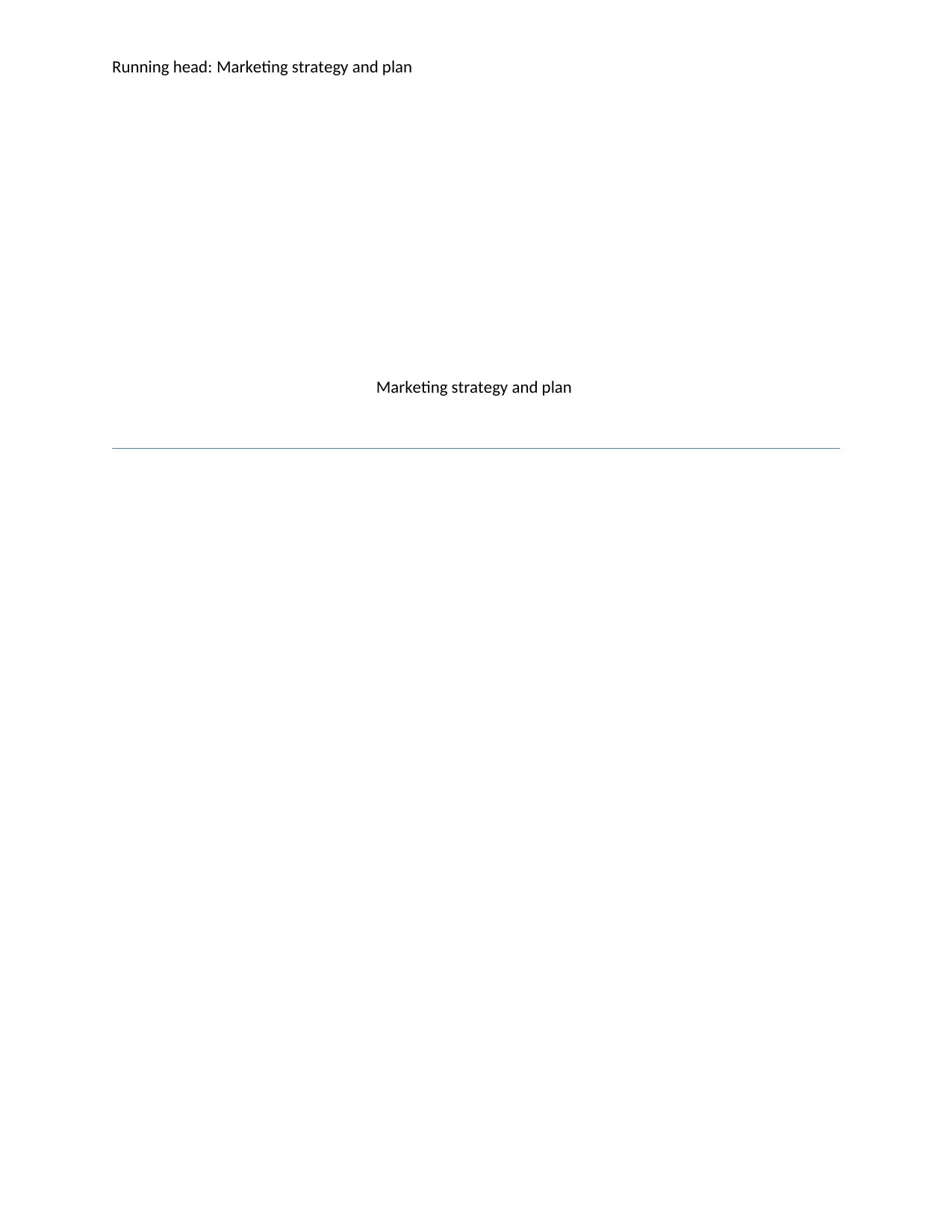
Running head: Marketing strategy and plan
Marketing strategy and plan
Marketing strategy and plan
Paraphrase This Document
Need a fresh take? Get an instant paraphrase of this document with our AI Paraphraser
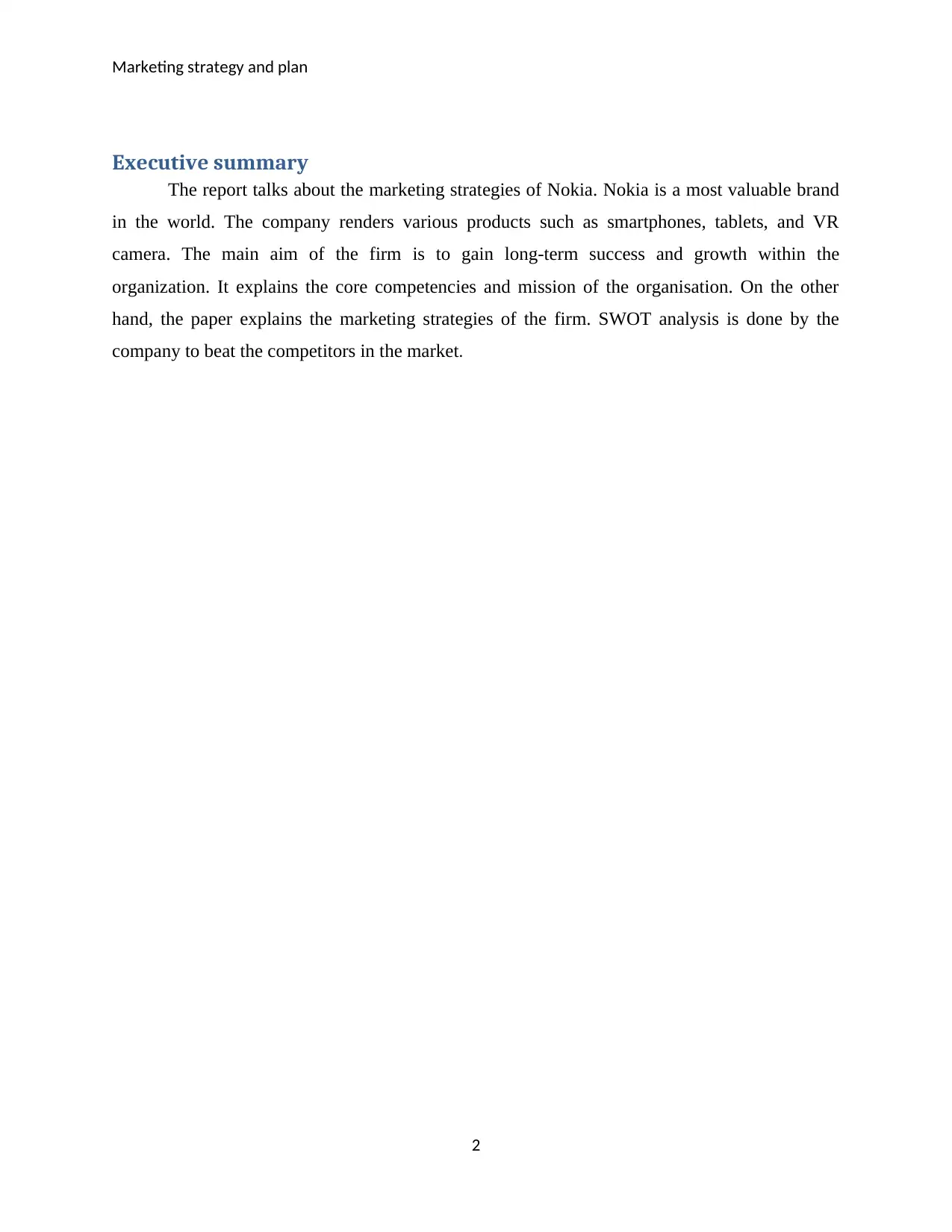
Marketing strategy and plan
Executive summary
The report talks about the marketing strategies of Nokia. Nokia is a most valuable brand
in the world. The company renders various products such as smartphones, tablets, and VR
camera. The main aim of the firm is to gain long-term success and growth within the
organization. It explains the core competencies and mission of the organisation. On the other
hand, the paper explains the marketing strategies of the firm. SWOT analysis is done by the
company to beat the competitors in the market.
2
Executive summary
The report talks about the marketing strategies of Nokia. Nokia is a most valuable brand
in the world. The company renders various products such as smartphones, tablets, and VR
camera. The main aim of the firm is to gain long-term success and growth within the
organization. It explains the core competencies and mission of the organisation. On the other
hand, the paper explains the marketing strategies of the firm. SWOT analysis is done by the
company to beat the competitors in the market.
2
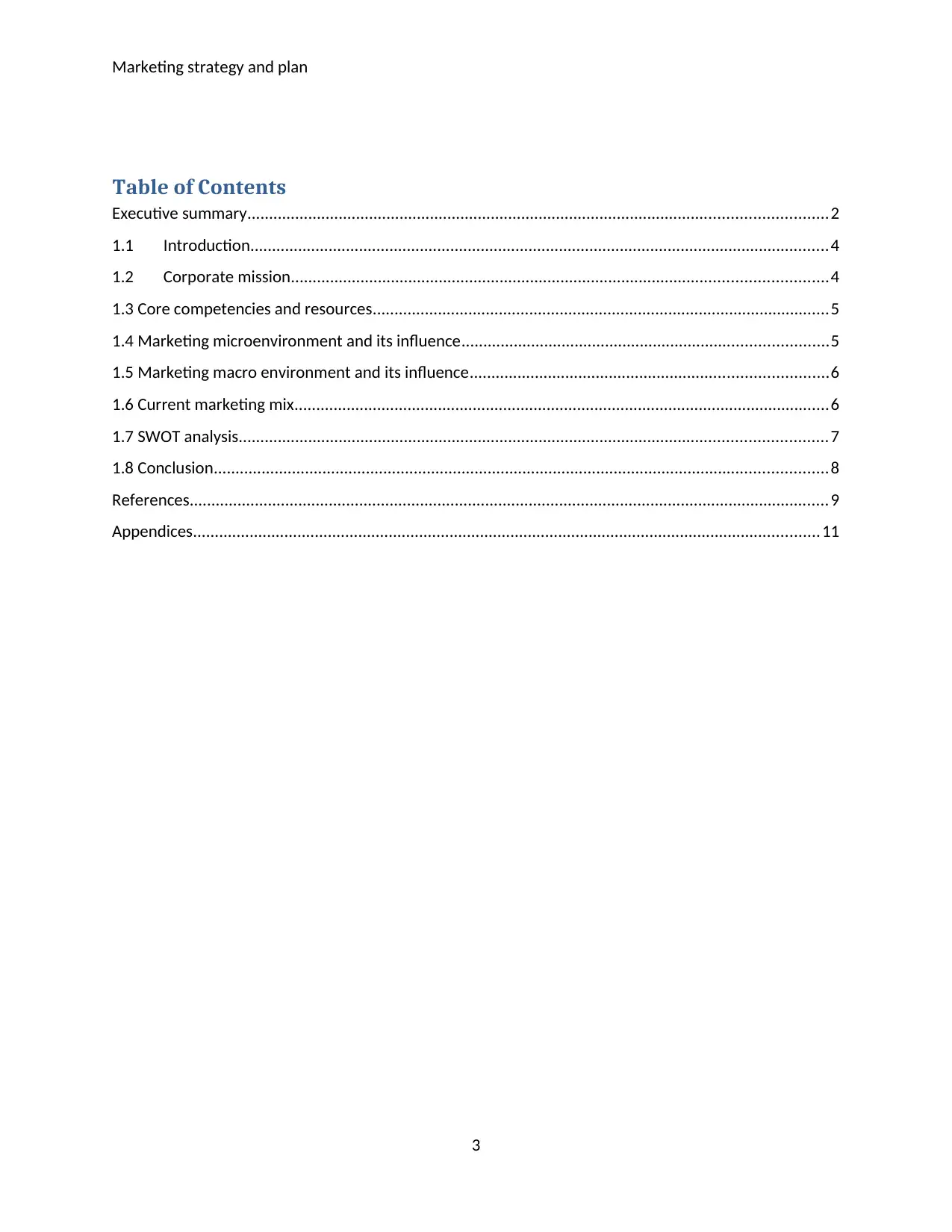
Marketing strategy and plan
Table of Contents
Executive summary.....................................................................................................................................2
1.1 Introduction.....................................................................................................................................4
1.2 Corporate mission...........................................................................................................................4
1.3 Core competencies and resources.........................................................................................................5
1.4 Marketing microenvironment and its influence....................................................................................5
1.5 Marketing macro environment and its influence..................................................................................6
1.6 Current marketing mix...........................................................................................................................6
1.7 SWOT analysis.......................................................................................................................................7
1.8 Conclusion.............................................................................................................................................8
References...................................................................................................................................................9
Appendices................................................................................................................................................11
3
Table of Contents
Executive summary.....................................................................................................................................2
1.1 Introduction.....................................................................................................................................4
1.2 Corporate mission...........................................................................................................................4
1.3 Core competencies and resources.........................................................................................................5
1.4 Marketing microenvironment and its influence....................................................................................5
1.5 Marketing macro environment and its influence..................................................................................6
1.6 Current marketing mix...........................................................................................................................6
1.7 SWOT analysis.......................................................................................................................................7
1.8 Conclusion.............................................................................................................................................8
References...................................................................................................................................................9
Appendices................................................................................................................................................11
3
⊘ This is a preview!⊘
Do you want full access?
Subscribe today to unlock all pages.

Trusted by 1+ million students worldwide
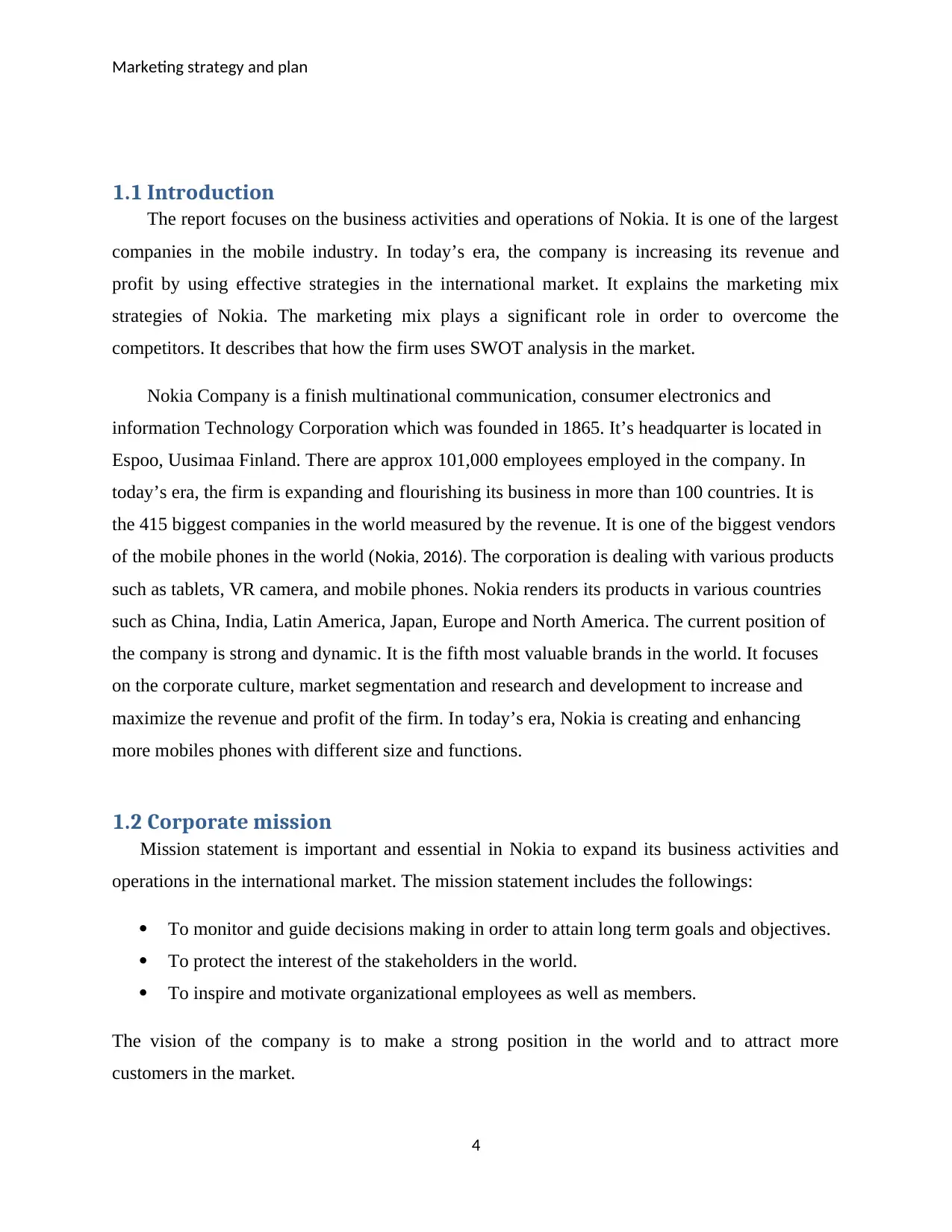
Marketing strategy and plan
1.1 Introduction
The report focuses on the business activities and operations of Nokia. It is one of the largest
companies in the mobile industry. In today’s era, the company is increasing its revenue and
profit by using effective strategies in the international market. It explains the marketing mix
strategies of Nokia. The marketing mix plays a significant role in order to overcome the
competitors. It describes that how the firm uses SWOT analysis in the market.
Nokia Company is a finish multinational communication, consumer electronics and
information Technology Corporation which was founded in 1865. It’s headquarter is located in
Espoo, Uusimaa Finland. There are approx 101,000 employees employed in the company. In
today’s era, the firm is expanding and flourishing its business in more than 100 countries. It is
the 415 biggest companies in the world measured by the revenue. It is one of the biggest vendors
of the mobile phones in the world (Nokia, 2016). The corporation is dealing with various products
such as tablets, VR camera, and mobile phones. Nokia renders its products in various countries
such as China, India, Latin America, Japan, Europe and North America. The current position of
the company is strong and dynamic. It is the fifth most valuable brands in the world. It focuses
on the corporate culture, market segmentation and research and development to increase and
maximize the revenue and profit of the firm. In today’s era, Nokia is creating and enhancing
more mobiles phones with different size and functions.
1.2 Corporate mission
Mission statement is important and essential in Nokia to expand its business activities and
operations in the international market. The mission statement includes the followings:
To monitor and guide decisions making in order to attain long term goals and objectives.
To protect the interest of the stakeholders in the world.
To inspire and motivate organizational employees as well as members.
The vision of the company is to make a strong position in the world and to attract more
customers in the market.
4
1.1 Introduction
The report focuses on the business activities and operations of Nokia. It is one of the largest
companies in the mobile industry. In today’s era, the company is increasing its revenue and
profit by using effective strategies in the international market. It explains the marketing mix
strategies of Nokia. The marketing mix plays a significant role in order to overcome the
competitors. It describes that how the firm uses SWOT analysis in the market.
Nokia Company is a finish multinational communication, consumer electronics and
information Technology Corporation which was founded in 1865. It’s headquarter is located in
Espoo, Uusimaa Finland. There are approx 101,000 employees employed in the company. In
today’s era, the firm is expanding and flourishing its business in more than 100 countries. It is
the 415 biggest companies in the world measured by the revenue. It is one of the biggest vendors
of the mobile phones in the world (Nokia, 2016). The corporation is dealing with various products
such as tablets, VR camera, and mobile phones. Nokia renders its products in various countries
such as China, India, Latin America, Japan, Europe and North America. The current position of
the company is strong and dynamic. It is the fifth most valuable brands in the world. It focuses
on the corporate culture, market segmentation and research and development to increase and
maximize the revenue and profit of the firm. In today’s era, Nokia is creating and enhancing
more mobiles phones with different size and functions.
1.2 Corporate mission
Mission statement is important and essential in Nokia to expand its business activities and
operations in the international market. The mission statement includes the followings:
To monitor and guide decisions making in order to attain long term goals and objectives.
To protect the interest of the stakeholders in the world.
To inspire and motivate organizational employees as well as members.
The vision of the company is to make a strong position in the world and to attract more
customers in the market.
4
Paraphrase This Document
Need a fresh take? Get an instant paraphrase of this document with our AI Paraphraser
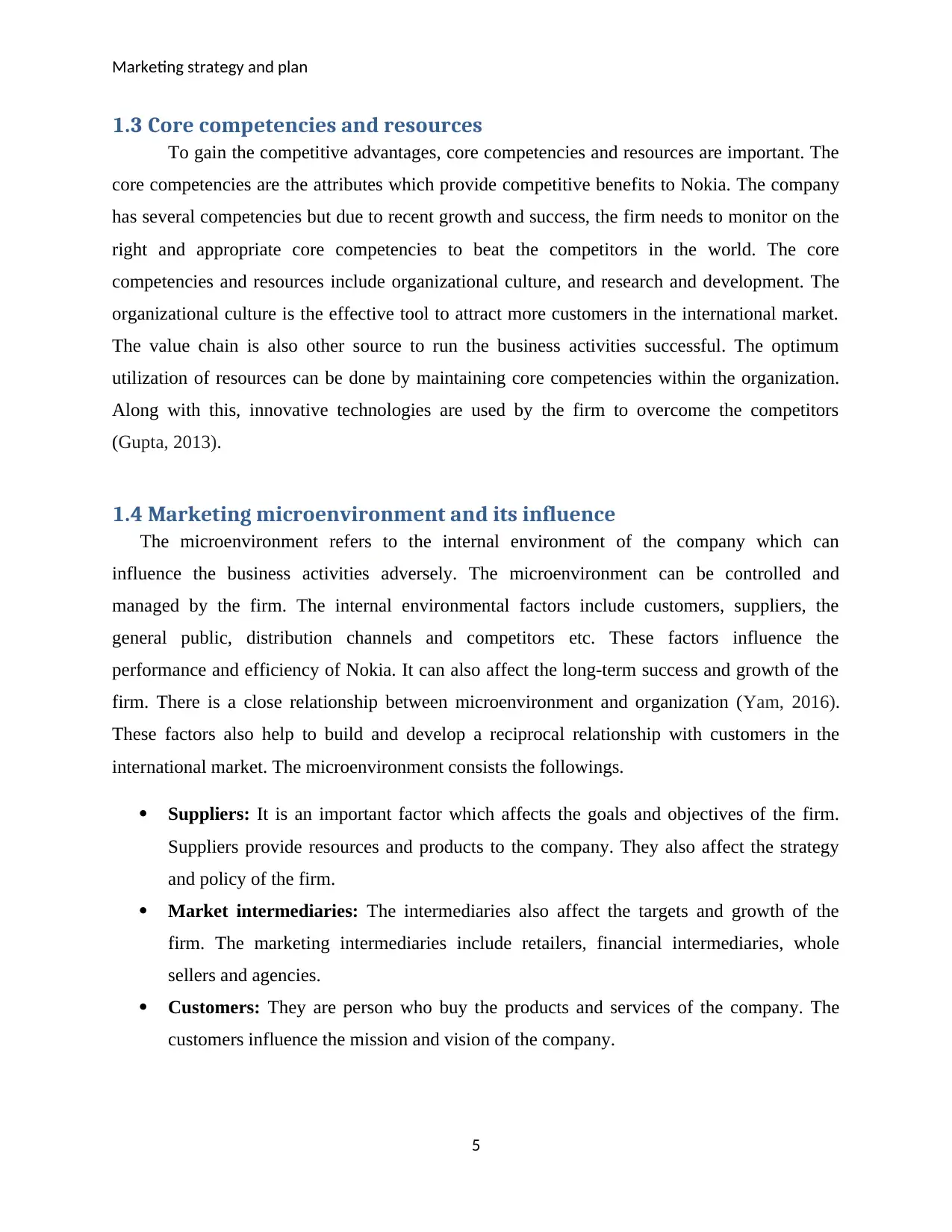
Marketing strategy and plan
1.3 Core competencies and resources
To gain the competitive advantages, core competencies and resources are important. The
core competencies are the attributes which provide competitive benefits to Nokia. The company
has several competencies but due to recent growth and success, the firm needs to monitor on the
right and appropriate core competencies to beat the competitors in the world. The core
competencies and resources include organizational culture, and research and development. The
organizational culture is the effective tool to attract more customers in the international market.
The value chain is also other source to run the business activities successful. The optimum
utilization of resources can be done by maintaining core competencies within the organization.
Along with this, innovative technologies are used by the firm to overcome the competitors
(Gupta, 2013).
1.4 Marketing microenvironment and its influence
The microenvironment refers to the internal environment of the company which can
influence the business activities adversely. The microenvironment can be controlled and
managed by the firm. The internal environmental factors include customers, suppliers, the
general public, distribution channels and competitors etc. These factors influence the
performance and efficiency of Nokia. It can also affect the long-term success and growth of the
firm. There is a close relationship between microenvironment and organization (Yam, 2016).
These factors also help to build and develop a reciprocal relationship with customers in the
international market. The microenvironment consists the followings.
Suppliers: It is an important factor which affects the goals and objectives of the firm.
Suppliers provide resources and products to the company. They also affect the strategy
and policy of the firm.
Market intermediaries: The intermediaries also affect the targets and growth of the
firm. The marketing intermediaries include retailers, financial intermediaries, whole
sellers and agencies.
Customers: They are person who buy the products and services of the company. The
customers influence the mission and vision of the company.
5
1.3 Core competencies and resources
To gain the competitive advantages, core competencies and resources are important. The
core competencies are the attributes which provide competitive benefits to Nokia. The company
has several competencies but due to recent growth and success, the firm needs to monitor on the
right and appropriate core competencies to beat the competitors in the world. The core
competencies and resources include organizational culture, and research and development. The
organizational culture is the effective tool to attract more customers in the international market.
The value chain is also other source to run the business activities successful. The optimum
utilization of resources can be done by maintaining core competencies within the organization.
Along with this, innovative technologies are used by the firm to overcome the competitors
(Gupta, 2013).
1.4 Marketing microenvironment and its influence
The microenvironment refers to the internal environment of the company which can
influence the business activities adversely. The microenvironment can be controlled and
managed by the firm. The internal environmental factors include customers, suppliers, the
general public, distribution channels and competitors etc. These factors influence the
performance and efficiency of Nokia. It can also affect the long-term success and growth of the
firm. There is a close relationship between microenvironment and organization (Yam, 2016).
These factors also help to build and develop a reciprocal relationship with customers in the
international market. The microenvironment consists the followings.
Suppliers: It is an important factor which affects the goals and objectives of the firm.
Suppliers provide resources and products to the company. They also affect the strategy
and policy of the firm.
Market intermediaries: The intermediaries also affect the targets and growth of the
firm. The marketing intermediaries include retailers, financial intermediaries, whole
sellers and agencies.
Customers: They are person who buy the products and services of the company. The
customers influence the mission and vision of the company.
5
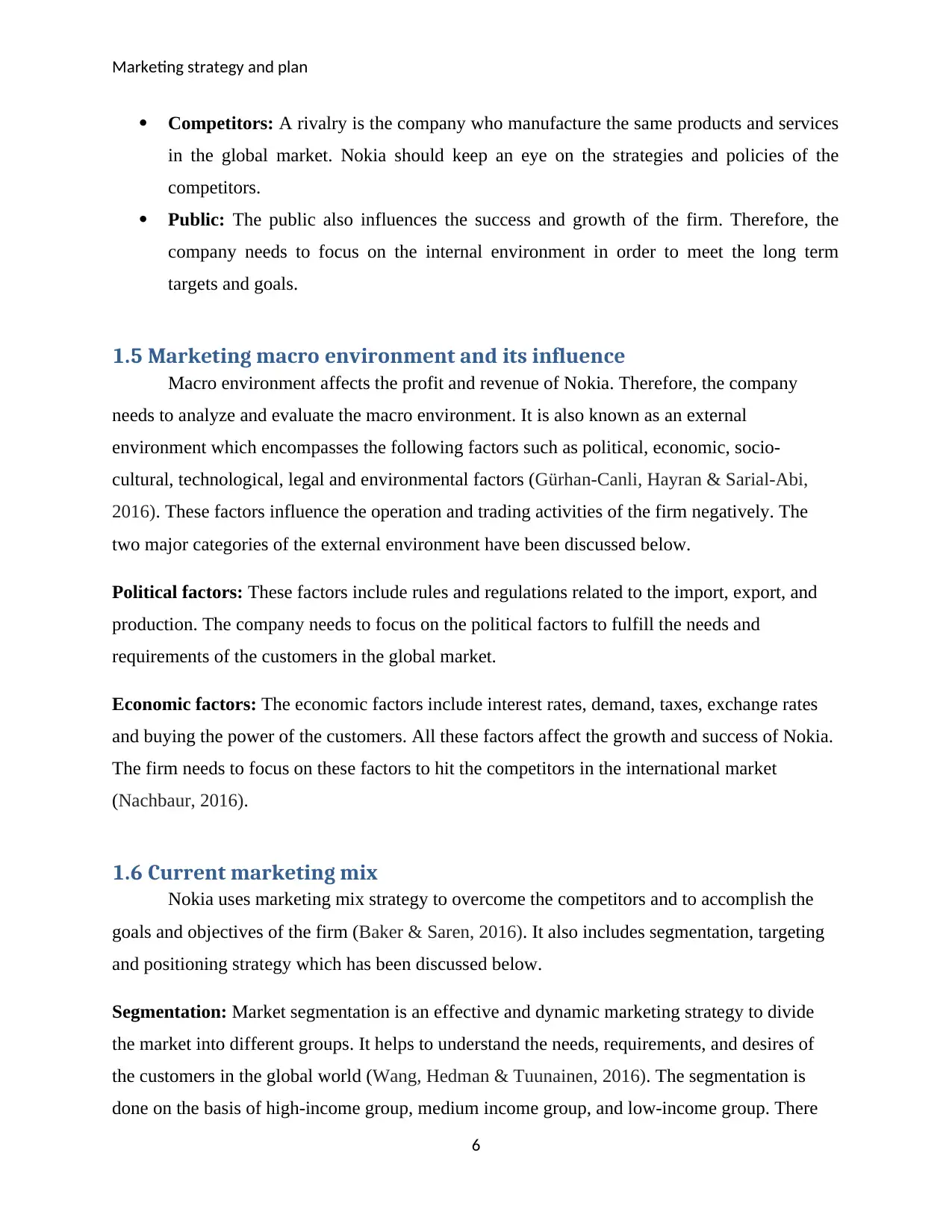
Marketing strategy and plan
Competitors: A rivalry is the company who manufacture the same products and services
in the global market. Nokia should keep an eye on the strategies and policies of the
competitors.
Public: The public also influences the success and growth of the firm. Therefore, the
company needs to focus on the internal environment in order to meet the long term
targets and goals.
1.5 Marketing macro environment and its influence
Macro environment affects the profit and revenue of Nokia. Therefore, the company
needs to analyze and evaluate the macro environment. It is also known as an external
environment which encompasses the following factors such as political, economic, socio-
cultural, technological, legal and environmental factors (Gürhan-Canli, Hayran & Sarial-Abi,
2016). These factors influence the operation and trading activities of the firm negatively. The
two major categories of the external environment have been discussed below.
Political factors: These factors include rules and regulations related to the import, export, and
production. The company needs to focus on the political factors to fulfill the needs and
requirements of the customers in the global market.
Economic factors: The economic factors include interest rates, demand, taxes, exchange rates
and buying the power of the customers. All these factors affect the growth and success of Nokia.
The firm needs to focus on these factors to hit the competitors in the international market
(Nachbaur, 2016).
1.6 Current marketing mix
Nokia uses marketing mix strategy to overcome the competitors and to accomplish the
goals and objectives of the firm (Baker & Saren, 2016). It also includes segmentation, targeting
and positioning strategy which has been discussed below.
Segmentation: Market segmentation is an effective and dynamic marketing strategy to divide
the market into different groups. It helps to understand the needs, requirements, and desires of
the customers in the global world (Wang, Hedman & Tuunainen, 2016). The segmentation is
done on the basis of high-income group, medium income group, and low-income group. There
6
Competitors: A rivalry is the company who manufacture the same products and services
in the global market. Nokia should keep an eye on the strategies and policies of the
competitors.
Public: The public also influences the success and growth of the firm. Therefore, the
company needs to focus on the internal environment in order to meet the long term
targets and goals.
1.5 Marketing macro environment and its influence
Macro environment affects the profit and revenue of Nokia. Therefore, the company
needs to analyze and evaluate the macro environment. It is also known as an external
environment which encompasses the following factors such as political, economic, socio-
cultural, technological, legal and environmental factors (Gürhan-Canli, Hayran & Sarial-Abi,
2016). These factors influence the operation and trading activities of the firm negatively. The
two major categories of the external environment have been discussed below.
Political factors: These factors include rules and regulations related to the import, export, and
production. The company needs to focus on the political factors to fulfill the needs and
requirements of the customers in the global market.
Economic factors: The economic factors include interest rates, demand, taxes, exchange rates
and buying the power of the customers. All these factors affect the growth and success of Nokia.
The firm needs to focus on these factors to hit the competitors in the international market
(Nachbaur, 2016).
1.6 Current marketing mix
Nokia uses marketing mix strategy to overcome the competitors and to accomplish the
goals and objectives of the firm (Baker & Saren, 2016). It also includes segmentation, targeting
and positioning strategy which has been discussed below.
Segmentation: Market segmentation is an effective and dynamic marketing strategy to divide
the market into different groups. It helps to understand the needs, requirements, and desires of
the customers in the global world (Wang, Hedman & Tuunainen, 2016). The segmentation is
done on the basis of high-income group, medium income group, and low-income group. There
6
⊘ This is a preview!⊘
Do you want full access?
Subscribe today to unlock all pages.

Trusted by 1+ million students worldwide
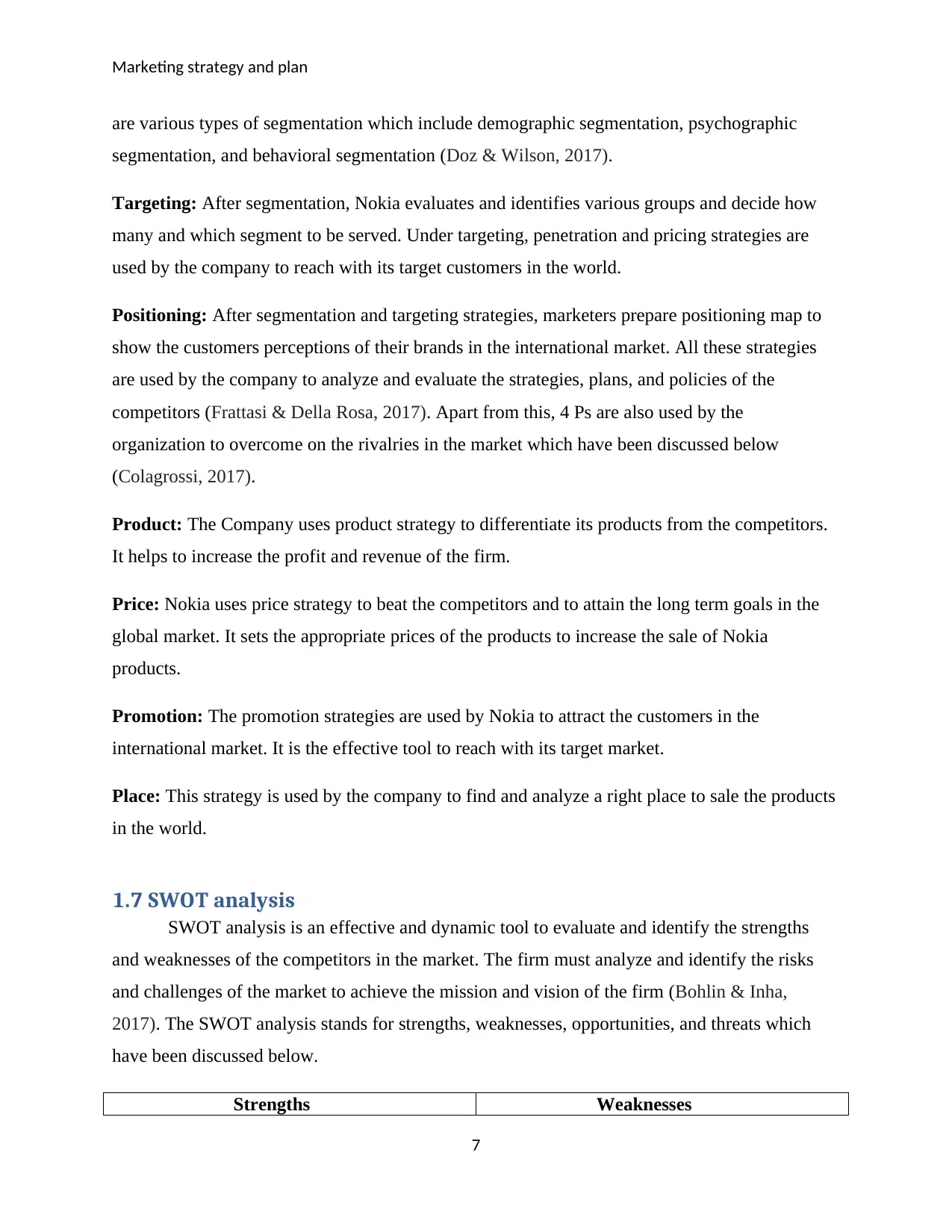
Marketing strategy and plan
are various types of segmentation which include demographic segmentation, psychographic
segmentation, and behavioral segmentation (Doz & Wilson, 2017).
Targeting: After segmentation, Nokia evaluates and identifies various groups and decide how
many and which segment to be served. Under targeting, penetration and pricing strategies are
used by the company to reach with its target customers in the world.
Positioning: After segmentation and targeting strategies, marketers prepare positioning map to
show the customers perceptions of their brands in the international market. All these strategies
are used by the company to analyze and evaluate the strategies, plans, and policies of the
competitors (Frattasi & Della Rosa, 2017). Apart from this, 4 Ps are also used by the
organization to overcome on the rivalries in the market which have been discussed below
(Colagrossi, 2017).
Product: The Company uses product strategy to differentiate its products from the competitors.
It helps to increase the profit and revenue of the firm.
Price: Nokia uses price strategy to beat the competitors and to attain the long term goals in the
global market. It sets the appropriate prices of the products to increase the sale of Nokia
products.
Promotion: The promotion strategies are used by Nokia to attract the customers in the
international market. It is the effective tool to reach with its target market.
Place: This strategy is used by the company to find and analyze a right place to sale the products
in the world.
1.7 SWOT analysis
SWOT analysis is an effective and dynamic tool to evaluate and identify the strengths
and weaknesses of the competitors in the market. The firm must analyze and identify the risks
and challenges of the market to achieve the mission and vision of the firm (Bohlin & Inha,
2017). The SWOT analysis stands for strengths, weaknesses, opportunities, and threats which
have been discussed below.
Strengths Weaknesses
7
are various types of segmentation which include demographic segmentation, psychographic
segmentation, and behavioral segmentation (Doz & Wilson, 2017).
Targeting: After segmentation, Nokia evaluates and identifies various groups and decide how
many and which segment to be served. Under targeting, penetration and pricing strategies are
used by the company to reach with its target customers in the world.
Positioning: After segmentation and targeting strategies, marketers prepare positioning map to
show the customers perceptions of their brands in the international market. All these strategies
are used by the company to analyze and evaluate the strategies, plans, and policies of the
competitors (Frattasi & Della Rosa, 2017). Apart from this, 4 Ps are also used by the
organization to overcome on the rivalries in the market which have been discussed below
(Colagrossi, 2017).
Product: The Company uses product strategy to differentiate its products from the competitors.
It helps to increase the profit and revenue of the firm.
Price: Nokia uses price strategy to beat the competitors and to attain the long term goals in the
global market. It sets the appropriate prices of the products to increase the sale of Nokia
products.
Promotion: The promotion strategies are used by Nokia to attract the customers in the
international market. It is the effective tool to reach with its target market.
Place: This strategy is used by the company to find and analyze a right place to sale the products
in the world.
1.7 SWOT analysis
SWOT analysis is an effective and dynamic tool to evaluate and identify the strengths
and weaknesses of the competitors in the market. The firm must analyze and identify the risks
and challenges of the market to achieve the mission and vision of the firm (Bohlin & Inha,
2017). The SWOT analysis stands for strengths, weaknesses, opportunities, and threats which
have been discussed below.
Strengths Weaknesses
7
Paraphrase This Document
Need a fresh take? Get an instant paraphrase of this document with our AI Paraphraser
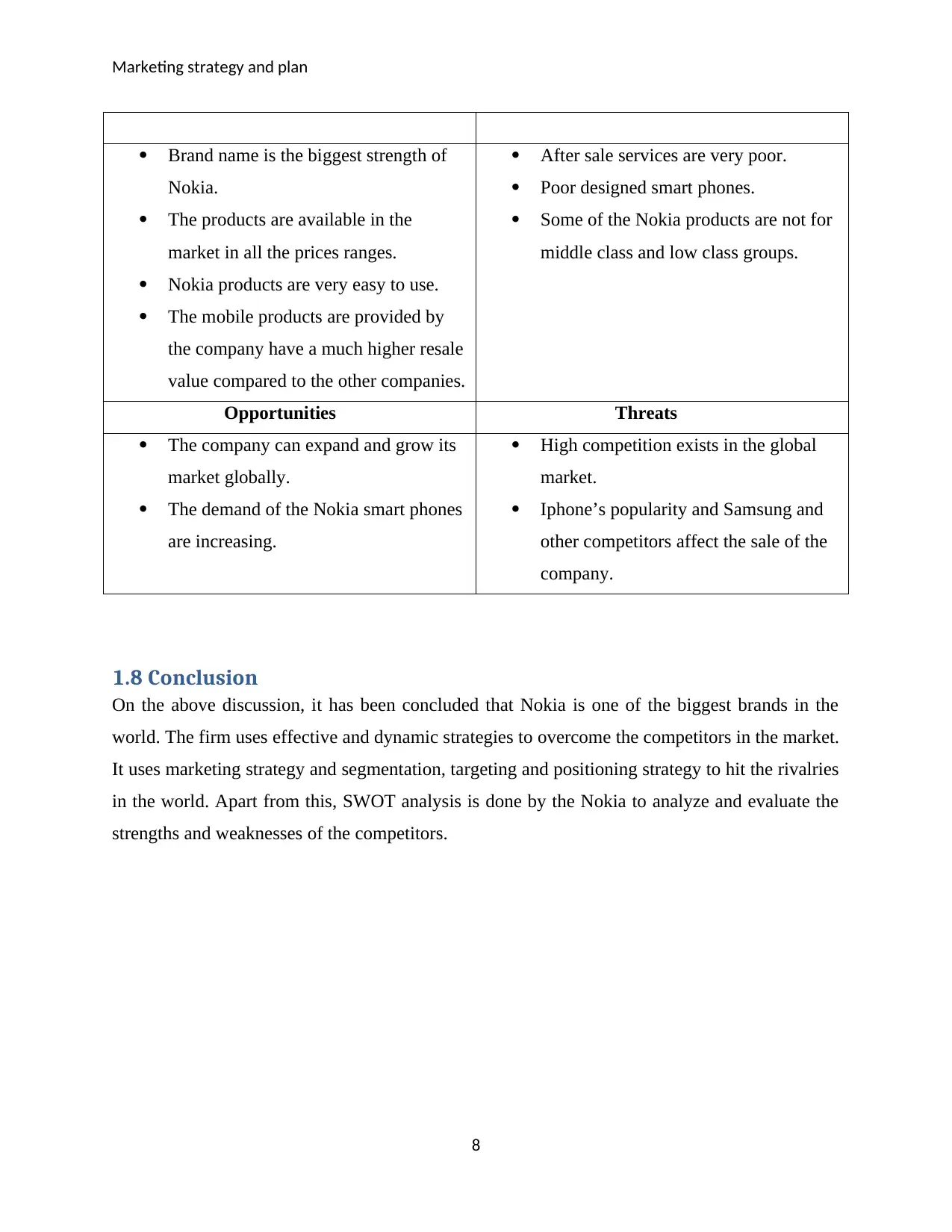
Marketing strategy and plan
Brand name is the biggest strength of
Nokia.
The products are available in the
market in all the prices ranges.
Nokia products are very easy to use.
The mobile products are provided by
the company have a much higher resale
value compared to the other companies.
After sale services are very poor.
Poor designed smart phones.
Some of the Nokia products are not for
middle class and low class groups.
Opportunities Threats
The company can expand and grow its
market globally.
The demand of the Nokia smart phones
are increasing.
High competition exists in the global
market.
Iphone’s popularity and Samsung and
other competitors affect the sale of the
company.
1.8 Conclusion
On the above discussion, it has been concluded that Nokia is one of the biggest brands in the
world. The firm uses effective and dynamic strategies to overcome the competitors in the market.
It uses marketing strategy and segmentation, targeting and positioning strategy to hit the rivalries
in the world. Apart from this, SWOT analysis is done by the Nokia to analyze and evaluate the
strengths and weaknesses of the competitors.
8
Brand name is the biggest strength of
Nokia.
The products are available in the
market in all the prices ranges.
Nokia products are very easy to use.
The mobile products are provided by
the company have a much higher resale
value compared to the other companies.
After sale services are very poor.
Poor designed smart phones.
Some of the Nokia products are not for
middle class and low class groups.
Opportunities Threats
The company can expand and grow its
market globally.
The demand of the Nokia smart phones
are increasing.
High competition exists in the global
market.
Iphone’s popularity and Samsung and
other competitors affect the sale of the
company.
1.8 Conclusion
On the above discussion, it has been concluded that Nokia is one of the biggest brands in the
world. The firm uses effective and dynamic strategies to overcome the competitors in the market.
It uses marketing strategy and segmentation, targeting and positioning strategy to hit the rivalries
in the world. Apart from this, SWOT analysis is done by the Nokia to analyze and evaluate the
strengths and weaknesses of the competitors.
8
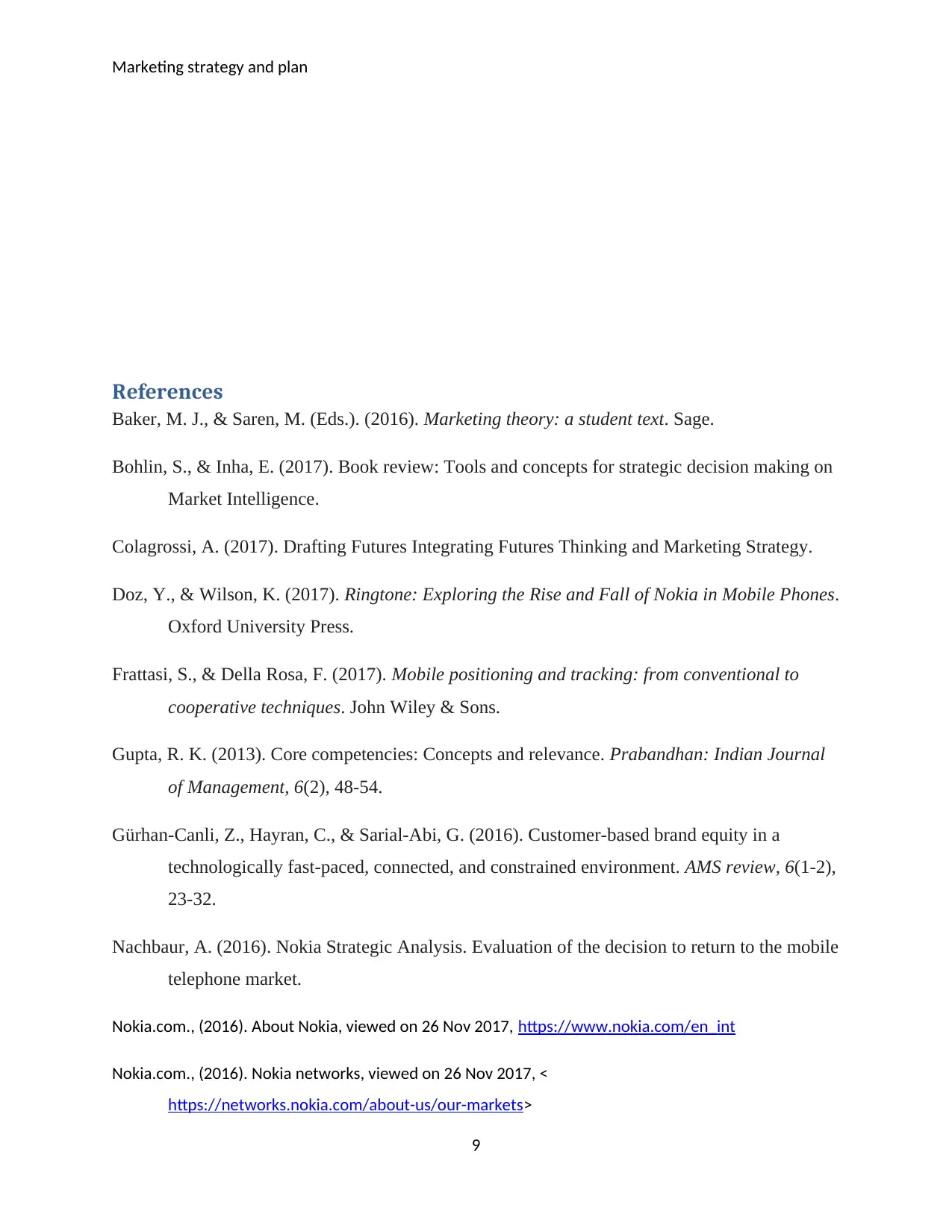
Marketing strategy and plan
References
Baker, M. J., & Saren, M. (Eds.). (2016). Marketing theory: a student text. Sage.
Bohlin, S., & Inha, E. (2017). Book review: Tools and concepts for strategic decision making on
Market Intelligence.
Colagrossi, A. (2017). Drafting Futures Integrating Futures Thinking and Marketing Strategy.
Doz, Y., & Wilson, K. (2017). Ringtone: Exploring the Rise and Fall of Nokia in Mobile Phones.
Oxford University Press.
Frattasi, S., & Della Rosa, F. (2017). Mobile positioning and tracking: from conventional to
cooperative techniques. John Wiley & Sons.
Gupta, R. K. (2013). Core competencies: Concepts and relevance. Prabandhan: Indian Journal
of Management, 6(2), 48-54.
Gürhan-Canli, Z., Hayran, C., & Sarial-Abi, G. (2016). Customer-based brand equity in a
technologically fast-paced, connected, and constrained environment. AMS review, 6(1-2),
23-32.
Nachbaur, A. (2016). Nokia Strategic Analysis. Evaluation of the decision to return to the mobile
telephone market.
Nokia.com., (2016). About Nokia, viewed on 26 Nov 2017, https://www.nokia.com/en_int
Nokia.com., (2016). Nokia networks, viewed on 26 Nov 2017, <
https://networks.nokia.com/about-us/our-markets>
9
References
Baker, M. J., & Saren, M. (Eds.). (2016). Marketing theory: a student text. Sage.
Bohlin, S., & Inha, E. (2017). Book review: Tools and concepts for strategic decision making on
Market Intelligence.
Colagrossi, A. (2017). Drafting Futures Integrating Futures Thinking and Marketing Strategy.
Doz, Y., & Wilson, K. (2017). Ringtone: Exploring the Rise and Fall of Nokia in Mobile Phones.
Oxford University Press.
Frattasi, S., & Della Rosa, F. (2017). Mobile positioning and tracking: from conventional to
cooperative techniques. John Wiley & Sons.
Gupta, R. K. (2013). Core competencies: Concepts and relevance. Prabandhan: Indian Journal
of Management, 6(2), 48-54.
Gürhan-Canli, Z., Hayran, C., & Sarial-Abi, G. (2016). Customer-based brand equity in a
technologically fast-paced, connected, and constrained environment. AMS review, 6(1-2),
23-32.
Nachbaur, A. (2016). Nokia Strategic Analysis. Evaluation of the decision to return to the mobile
telephone market.
Nokia.com., (2016). About Nokia, viewed on 26 Nov 2017, https://www.nokia.com/en_int
Nokia.com., (2016). Nokia networks, viewed on 26 Nov 2017, <
https://networks.nokia.com/about-us/our-markets>
9
⊘ This is a preview!⊘
Do you want full access?
Subscribe today to unlock all pages.

Trusted by 1+ million students worldwide
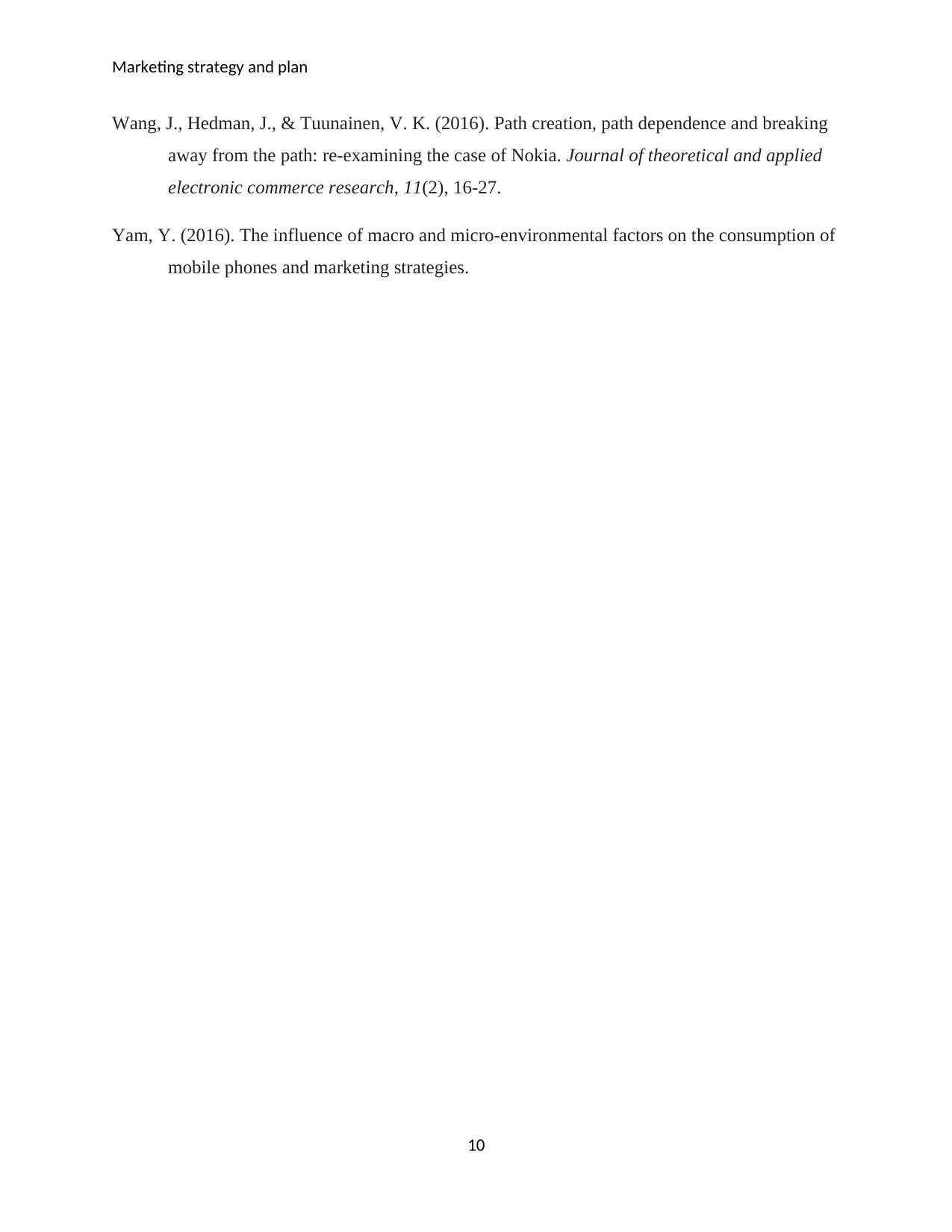
Marketing strategy and plan
Wang, J., Hedman, J., & Tuunainen, V. K. (2016). Path creation, path dependence and breaking
away from the path: re-examining the case of Nokia. Journal of theoretical and applied
electronic commerce research, 11(2), 16-27.
Yam, Y. (2016). The influence of macro and micro-environmental factors on the consumption of
mobile phones and marketing strategies.
10
Wang, J., Hedman, J., & Tuunainen, V. K. (2016). Path creation, path dependence and breaking
away from the path: re-examining the case of Nokia. Journal of theoretical and applied
electronic commerce research, 11(2), 16-27.
Yam, Y. (2016). The influence of macro and micro-environmental factors on the consumption of
mobile phones and marketing strategies.
10
Paraphrase This Document
Need a fresh take? Get an instant paraphrase of this document with our AI Paraphraser
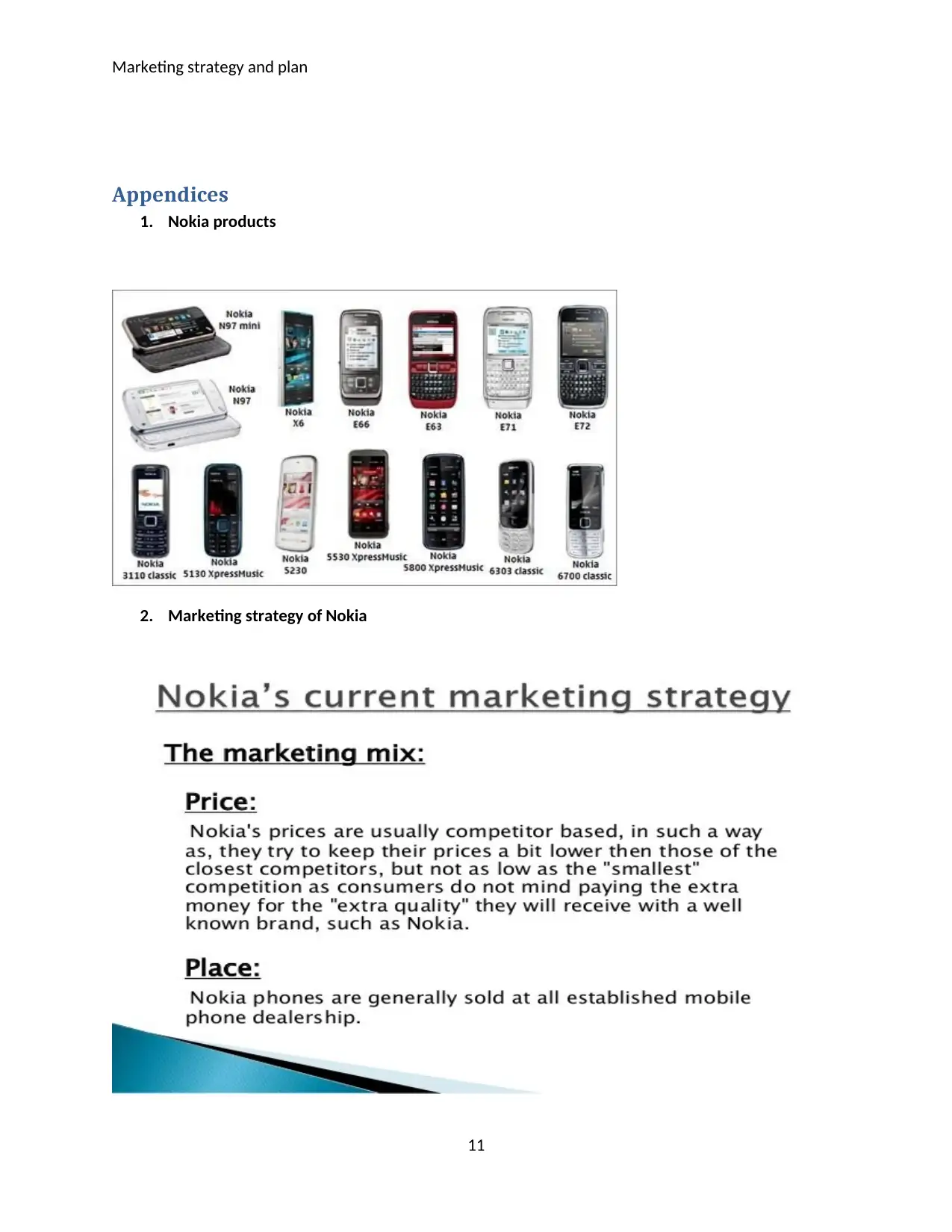
Marketing strategy and plan
Appendices
1. Nokia products
2. Marketing strategy of Nokia
11
Appendices
1. Nokia products
2. Marketing strategy of Nokia
11
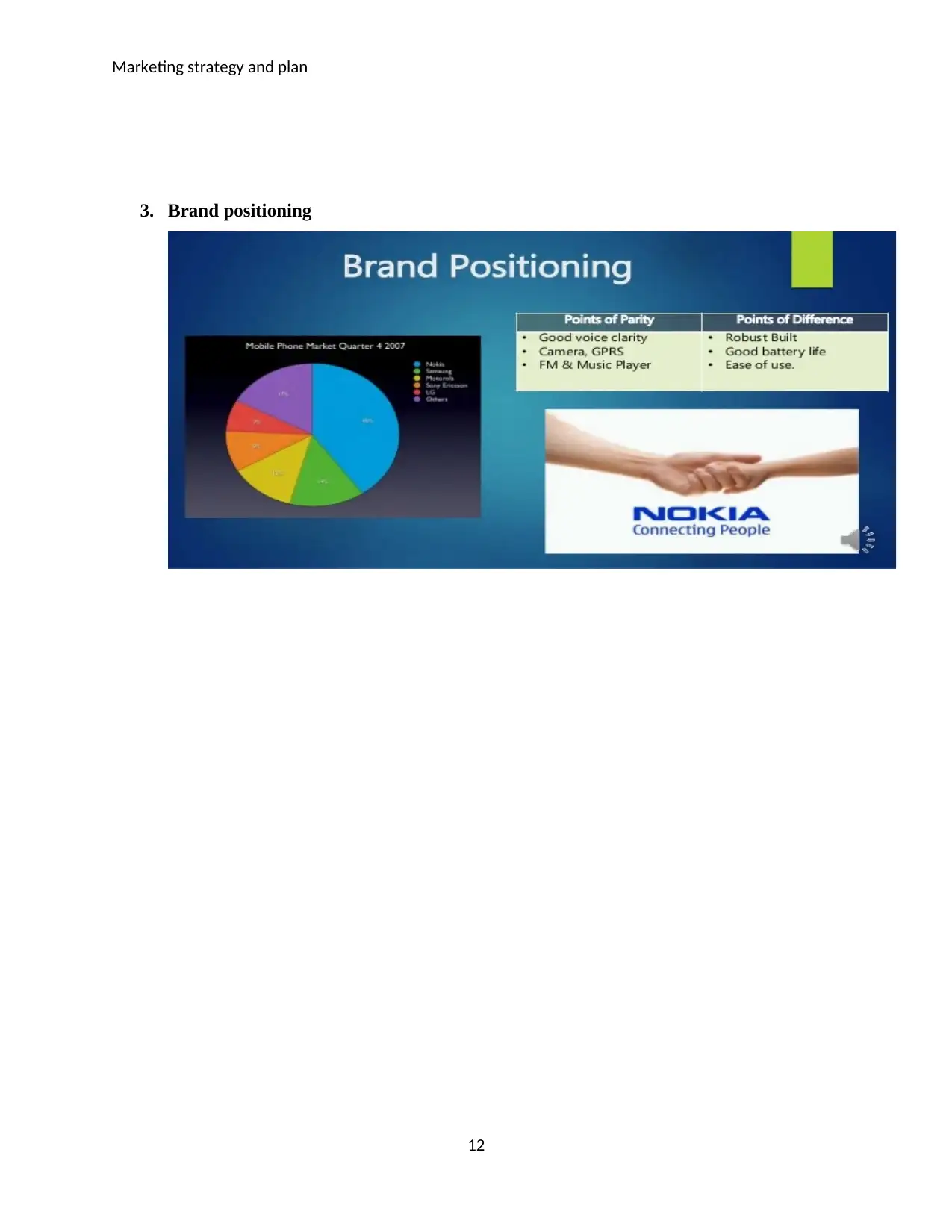
Marketing strategy and plan
3. Brand positioning
12
3. Brand positioning
12
⊘ This is a preview!⊘
Do you want full access?
Subscribe today to unlock all pages.

Trusted by 1+ million students worldwide
1 out of 12
Related Documents
Your All-in-One AI-Powered Toolkit for Academic Success.
+13062052269
info@desklib.com
Available 24*7 on WhatsApp / Email
![[object Object]](/_next/static/media/star-bottom.7253800d.svg)
Unlock your academic potential
Copyright © 2020–2025 A2Z Services. All Rights Reserved. Developed and managed by ZUCOL.





